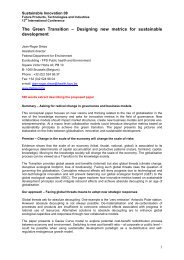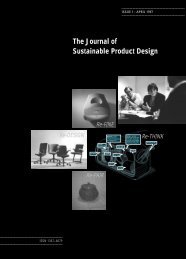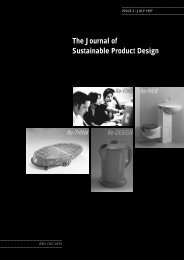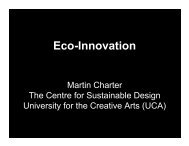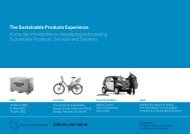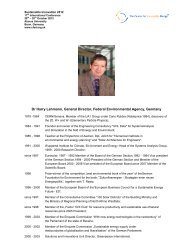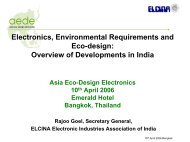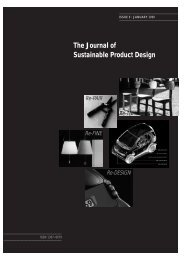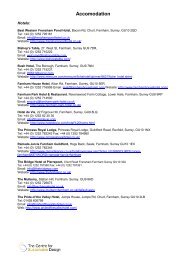Country report on the Indian electronics sector - The Centre for ...
Country report on the Indian electronics sector - The Centre for ...
Country report on the Indian electronics sector - The Centre for ...
Create successful ePaper yourself
Turn your PDF publications into a flip-book with our unique Google optimized e-Paper software.
4.0 Gaps and future needs<br />
<strong>The</strong> following gaps and needs were identified during <strong>the</strong> course<br />
of <strong>the</strong> industry survey menti<strong>on</strong>ed above and summarised in<br />
Annex 2.<br />
4.1 Management<br />
Major gaps<br />
f <strong>The</strong>re exists a huge c<strong>on</strong>ceptual gap in integrating<br />
envir<strong>on</strong>ment management and corporate resp<strong>on</strong>sibility into<br />
business strategy. Envir<strong>on</strong>ment management systems (EMS)<br />
are mainly driven by compliance pressures and not yet<br />
seen as best practice benchmarks. This in turn implies that<br />
envir<strong>on</strong>mental c<strong>on</strong>siderati<strong>on</strong>s are not incorporated during <strong>the</strong><br />
idea-generati<strong>on</strong> phase of product development. Thus, <strong>the</strong>re is<br />
a huge capacity gap in eco-design initiatives. This gap poses<br />
severe problems <strong>for</strong> SMEs in India in relati<strong>on</strong> to <strong>the</strong> potential<br />
eco-design requirements of <strong>the</strong> Energy-Using-Products (EuP)<br />
DIrective .<br />
f <strong>The</strong> problems <strong>for</strong> SMEs are likely to multiply, if large<br />
companies and MNCs switch to more reliable larger<br />
suppliers. This will result in shrinking or even complete loss<br />
of business <strong>for</strong> <strong>the</strong> SMEs. As <strong>the</strong> demand <strong>for</strong> recycling and<br />
greening of supply chains increases, <strong>the</strong> SME supplier base<br />
may gradually be phased out.<br />
f EMS practices (like eco design, recycling, etc) are not usually<br />
customer-centric with virtually no participati<strong>on</strong> of marketing<br />
professi<strong>on</strong>als in work <strong>on</strong> cleaner and greener products. <strong>The</strong><br />
signals and feedback from customers (i.e., <strong>the</strong> final c<strong>on</strong>sumer<br />
or OEMs/ODMs, tier two companies) are often missed out.<br />
This gap in business practice has meant that companies are<br />
unable to strike a balance between c<strong>on</strong>sumer needs and<br />
EMS practices. As a c<strong>on</strong>sequence, industrial designers do<br />
not feature in <strong>the</strong> value chain of <strong>the</strong> product.<br />
f <strong>The</strong>re is a severe in<strong>for</strong>mati<strong>on</strong> gap in <strong>the</strong> <strong>Indian</strong> government<br />
(policy making as well as implementati<strong>on</strong> agencies), in<br />
<strong>the</strong> area of best practices and internati<strong>on</strong>al compliance<br />
challenges. <strong>The</strong>re is no government agency which is solely<br />
resp<strong>on</strong>sible <strong>for</strong> tracking and benchmarking internati<strong>on</strong>al<br />
envir<strong>on</strong>mental compliance measures and appropriately<br />
adapting <strong>the</strong>m to <strong>the</strong> <strong>Indian</strong> ec<strong>on</strong>omic, social and political<br />
c<strong>on</strong>text. Industry (especially MNCs and larger companies)<br />
<strong>on</strong> <strong>the</strong> o<strong>the</strong>r hand, are ahead of <strong>the</strong> government in terms of<br />
in<strong>for</strong>mati<strong>on</strong> <strong>on</strong> best practices and compliance norms.<br />
Needs<br />
Asia Eco-Design Electr<strong>on</strong>ics (AEDE) · 17<br />
To cope with compliance challenges and change, suppliers<br />
to electr<strong>on</strong>ics OEMs/end-users need to induct proper<br />
management systems. <strong>The</strong> following management related<br />
acti<strong>on</strong>s are required, especially <strong>for</strong> SMEs:<br />
f Understanding and implementati<strong>on</strong> of EMS through<br />
ISO14000 certificati<strong>on</strong> and ISO 9001 quality systems.<br />
f Understanding <strong>the</strong> importance and perspectives of<br />
different stakeholders in business strategy.<br />
f Providing timely and relevant in<strong>for</strong>mati<strong>on</strong> to cope with<br />
<strong>on</strong>going changes and <strong>the</strong>ir implicati<strong>on</strong>s. This would call<br />
<strong>for</strong>: m<strong>on</strong>itoring systems, compliance evaluati<strong>on</strong> and c<strong>on</strong>trol<br />
measures, fine tuning internal communicati<strong>on</strong> and in<strong>for</strong>mati<strong>on</strong><br />
systems, developing extensive external communicati<strong>on</strong><br />
with customers, industry associati<strong>on</strong>s, nati<strong>on</strong>al regulatory<br />
authorities and government agencies.<br />
f Establishing effective planning systems including:<br />
a. Strategies to phase out hazardous substances<br />
b. Investment in new producti<strong>on</strong> lines, processes, materials,<br />
testing capabilities, training and o<strong>the</strong>r requirements.<br />
c. Strategic planning <strong>for</strong> re-designing products and<br />
producti<strong>on</strong> processes in tune with <strong>the</strong> needs of recycling,<br />
energy efficiency or o<strong>the</strong>r operati<strong>on</strong>al upgrading that may be<br />
directed by customers, OEMs or <strong>the</strong> final end-user. <strong>The</strong>se<br />
may include planning <strong>for</strong> labelling of finished products as per<br />
WEEE or o<strong>the</strong>r mandatory stipulati<strong>on</strong>s.<br />
f Formulating plans <strong>for</strong> SA 8000 and labour standards as<br />
per nati<strong>on</strong>al and internati<strong>on</strong>al norms<br />
f Planning <strong>for</strong> management and audit of quality and<br />
eco-design programmes.<br />
f Integrating eco-design and green procurement into<br />
organisati<strong>on</strong>al processes<br />
f Above all, <strong>the</strong>re is a need to educate management in<br />
developing countries about <strong>the</strong> correlati<strong>on</strong> between<br />
RoHS, WEEE, EuP, LPEUR and HARL and effective ecodesign.<br />
If <strong>the</strong> culture of eco-design can be disseminated<br />
and understood, products will meet <strong>the</strong> requirements of<br />
envir<strong>on</strong>mental legislati<strong>on</strong>s and sustainable trade. This can be<br />
d<strong>on</strong>e by showcasing examples of <strong>the</strong> few companies which<br />
have successfully implemented eco-design and effectively<br />
utilised it as a tool <strong>for</strong> commercial as well as envir<strong>on</strong>mental<br />
success.



